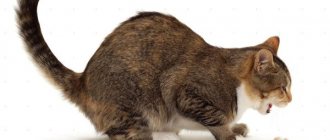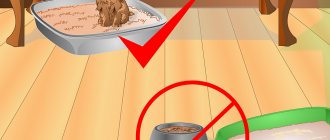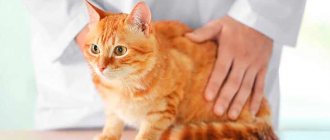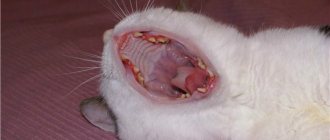Acute urinary retention - ischuria - is a pathological condition manifested by the absence of a full act of urination for more than 12 hours. The causes of ischuria can be mechanical, associated with impaired patency of the urinary tract, and neurological, associated with impaired nervous regulation of the tone of the smooth muscles of the genitourinary system.
This condition requires medical attention aimed at evacuating accumulated urine. The least traumatic option is considered to be manual emptying. In cats, this procedure is often referred to as massage or squeezing.
The procedure for manual emptying is simple and, if technical nuances are observed, absolutely safe for the animal. A doctor at any veterinary clinic will explain how to properly massage a cat’s bladder if the animal has problems with independent urination.
How and why to give a cat a bladder massage
Bladder massage is a procedure necessary to help a cat who cannot empty his bowels without assistance. It is also called bladder compression. The necessity and expediency of its implementation must be determined by a doctor, since any initiative of the animal owner in this matter can lead to dire consequences, even death.
Indications for use
Massage can be prescribed in case of problems with urination due to the following reasons:
- lesions of the nerves of the hind limbs (paralysis, paresis, etc.), often resulting from injuries;
- infectious or inflammatory diseases of the urinary system (urolithiasis, cystitis);
- congenital abnormalities in the development of the urinary tract;
- overexcitation in uncastrated cats, when significantly enlarged gonads clog the urethra.
For neurological damage to the limbs, the veterinarian usually prescribes constant manual emptying of the bladder; for other cases when the pet is unable to urinate on its own (for example, in the case of urolithiasis), the cause of this phenomenon should first be identified and eliminated.
Problems with urination become immediately noticeable. They manifest themselves in the form of the following symptoms:
- the animal spends a lot of time in the tray, but no urine is released at all or only a small amount is released, and the cat behaves restlessly at this time, sometimes meowing;
- the cat may try to urinate in different places in the house;
- appetite noticeably decreases or disappears;
- the pet becomes lethargic or, conversely, restless, and tends to limit any movements.
To determine the degree of bladder filling you need:
- Place the cat on a hard surface on all fours, gently holding it under the belly so that the hind limbs are closer to the owner.
- Place your hands on the back so that the thumbs are on the pet's croup, and the rest are palpating the abdomen in the area of the urinary canal.
- If during the procedure the pet tries to escape and becomes nervous, this indicates the presence of unpleasant sensations.
- Detection during palpation of a soft compaction the size of a walnut, in which liquid rolls freely under the fingers, indicates daily urinary retention, while a more elastic compaction the size of a tennis ball is a sign of absence of urination for more than two days. If the lump is larger and hard to the touch, this is a signal to urgently contact the veterinarian, since in this case you will most likely have to use a catheter for emptying.
Why is it necessary to eliminate the cause of the disease?
One of the symptoms of bladder or kidney disease is fluid retention . Mostly cats suffer from such phenomena. For example, urolithiasis mainly occurs in cats, since the urethra in cats is much wider than in cats. Neutered pets suffer from these ailments more than others.
They don't get all the hormones, and without quality nutrition and vitamins, they become weaker. Be sure to limit neutered animals from fish products, as they can cause an exacerbation.
ATTENTION! If your cat has kidney stones, give him the medicine "CatErvin". Thanks to the pleasant smell, animals will happily absorb these drops. According to the recommendation, the product should be given to the cat for prevention once every 3-4 months. It has diuretic properties, destroys small stones and sand itself.
To rid your pet of kidney stones, buy food for neutered cats that is specially marked. Infectious and cold pathologies can also cause fluid retention. Cats, especially those accustomed to a warm home, should not become overcooled.
To avoid such difficulties, you need high-quality care, proper nutrition and preventive measures. When you see that your pet cannot urinate, try to understand how long it has been since he urinated. Healthy animals walk three times a day, kittens up to four times. Cats can “accumulate” liquid in themselves, so concentrated urine is considered normal.
If a cat cannot defecate for several days, this is a very dangerous problem, since the body can be poisoned by urea. Manifestations of poisoning: lethargy, apathetic mood, lack of appetite.
How can you tell if your cat's bladder is full? This can be done quickly. Place the animal on its paws, clasp it with both hands so that your thumbs are located on the cat's rump, and use the remaining fingers to feel and palpate the belly. If your cat is constantly running to the toilet and squeezing out little things all the time, this may be enough to get rid of the poisoning.
Procedure for massage
Before starting the procedure, you need to calm your pet with gentle words or stroking the head. At the same time, you need to carefully palpate the abdomen to assess the degree of bladder density.
- Place the cat on its back or side, but the procedure can also be carried out in a standing position.
- Check that there are no tiny stones on the penis that could block the passage of urine. If the latter are detected, they must be removed: run your fingers, lubricated with a special gel or soap, from the edge to the base of the genital organ, gently squeezing it.
- Cup your hand and gently massage the bladder, making clockwise circular movements to direct the flow of urine towards the external genitalia. You can also try light pressure on both sides of the bladder with two palms.
Important! In no case should you make strong pressing movements, since any carelessness can lead to rupture of the bladder. The main thing in the massage process is not strength, but the correctness of movements.
- After some time, a small amount of urine will begin to be released, although a small amount of blood will be acceptable. With urolithiasis, accumulations of sand and salts will come out of the body in the form of a white paste.
- If the pet breaks out and scratches, you can ask an assistant to hold the cat by the paws and soothe it by stroking the neck.
- If all manipulations are done correctly, the animal will be able to urinate in the tray. It is important that the bladder is at least 50% empty. If the cat does not resist too much during the massage, you can continue the procedure until it is completely emptied.
For the first time, your pet will probably disapprove of the massage procedure and pressure on the stomach. But it is important to understand that the health and life expectancy of the cat depends on how fully and correctly the procedure is performed, since prolonged retention of urine in the body causes poisoning of the animal.
You can also contact our site's staff veterinarian, who will respond to them as soon as possible in the comment box below.
Determining the degree of bladder fullness
The cat's nervousness will indicate the presence of pain.
You can determine the degree of filling of the bag yourself.
- To do this, you need to put the cat on all fours, slightly supporting it under its belly.
- The animal should be with its hind limbs closer to the owner.
- Hands should be placed on the cat's back so that both thumbs are on the animal's rump, and the rest should be palpated on the stomach closer to the urinary canal.
Nervousness and attempts by the cat to escape will indicate the presence of pain, which means immediately contacting a doctor.
Feeling the bladder
To more specifically determine the topographic location of the organ, you should place your palm closer to the base of the tail, perpendicular to the ridge. The projection of the upper border of the organ will be the side of the palm opposite to the tail. Normally, in the absence of urine, a soft, insignificant fluctuation should be felt under the fingers, evenly distributed within the boundaries of the organ, while the boundaries themselves are not felt.
Normally, in the absence of urine, the boundaries of the organ are not felt.
Daily urea retention
The presence of daily urea retention will be indicated by a compaction of soft consistency the size of a walnut.
The feeling of liquid will roll freely under your fingers. A delay of more than two days will be felt under the fingers by a compaction, the size of a tennis ball, with a consistency reminiscent of soft rubber, with a slight fluctuation.
If a larger lump with a harder consistency is felt, consult a doctor immediately . Your cat will most likely need to empty his bladder using a catheter.
If upon palpation there is a seal, the bladder should be emptied using a catheter.
How to treat urethritis
The basis of complex treatment is the use of disinfectants and diuretics. Treatment of urethritis in cats is carried out with drugs that do not irritate the mucous membrane, for example, Argumistin. Treatment of urethritis in cats, like treatment of urethritis in dogs, involves the use of “Argumistin,” which can treat diseases of the mucous membranes. The medicine is prescribed by a veterinarian and administered through a catheter.
Sources:
https://koti-koshki.ru/uretrit-u-kota.html https://vashipitomcy.ru/publ/zdorove/bolezni/uretrit_u_koshek_simptomy_i_lechenie_vospalenija/15-1-0-791 https://argumistin.ru/dlya- domashnix-zhivotnyx/lechenie-uretrita-u-koshek-i-sobak/
Cat's bladder
The anatomical structure of domestic animals is slightly different from that of humans, so it is difficult to independently determine where a cat’s bladder is located. If its function is impaired, the pet’s urinary process becomes difficult, pain and other negative symptoms are possible. If there are changes in the structure or functioning of an internal organ, then you should contact a veterinarian who will select treatment if necessary.
Features of the cat's bladder
How is it arranged?
The location of the internal organ in a kitten and an adult is slightly different than in a person, and its fullness also differs significantly. The urea has several layers, which differ in individual characteristics:
- Outer side. The membrane contains connective tissue, under which smooth muscles are located, which ensure the pushing of urine and the urge to excrete it.
- Submucosal tissues. They are a complex membrane that has highly elastic fibers and helps the wall maintain the cat’s bladder in good shape.
- Mucous membrane. Its location is in the cavity of the organ, which makes it possible to stretch and return to normal when it is full. And also in this area a special secret is produced that protects the urea from the negative effects of pathogenic microflora.
Veterinarians focus the attention of cat owners on the fact that although the bladder has a less complex structure than other vital internal organs, even if it is slightly damaged and untreated, unpleasant consequences are possible that threaten the health and life of the pet.
Main functions
A cat’s bladder is an important organ, and if its functioning is disrupted, deviations in the functioning of many body structures can occur. The urethra in kittens acts as a reservoir in which urine accumulates until it is excreted through the urethra. When its dysfunction is impaired, excessive filling of the bladder occurs, which is why urine is not excreted on time, stretches the walls and has a negative effect on the kidneys and other structures of the urinary system.
How to check an organ?
A person can independently palpate a cat’s bladder at home. When it is hard and enlarged, it signals the development of serious diseases. Sometimes it is difficult to feel the internal organ, especially if it is not complete. In this case, follow these recommendations:
- The cat is placed on a flat surface so that it rests on all its paws. If the pet's body is in a different position, it is impossible to palpate the bladder.
- With one hand they support the cat under the peritoneum, and with the other they try to secure it as firmly as possible by the skin on the back, while trying not to hurt the pet.
- The person’s hand is positioned so that the thumbs can feel the croup, and the rest can touch the stomach.
- When the bladder is overfilled with urine, it may be mistaken for a tumor or a lump that has an elastic consistency. If you press on it, the cat may meow or scratch due to pain. In such a case, emergency catheterization may be required to remove accumulated urine.
Return to contents
What happens with a neurological deficit?
When the spinal cord is damaged, the innervation (nerve conduction) of the bladder is disrupted.
Depending on the degree of damage, urination may be completely absent and not restored (in case of grade 6 deficiency and complete paralysis of the pelvic limbs), or it may recover over time. In both cases, it is necessary to prevent bladder atony and the development of inflammatory processes (cystitis, urethritis, urolithiasis).
There is also a dependence on the level of damage - with damage of the upper motor neuron type, hypertonicity of the bladder and sphincter is observed, urination is either completely absent or occurs frequently and in small portions. The cat cannot go to the toilet at will and relax the sphincter in a controlled manner. It is with this type of injury that manual squeezing of the bladder is necessary. In this case, urine can flow out when the bladder is full - its walls stretch to a certain limit, after which urine begins to flow out. Owners often confuse this process with spontaneous urination, so it is important to understand that if the bladder is already so overstretched that urine leaks out, this can lead to serious complications due to atony of the bladder walls and stagnation of urine. Therefore, after any injury that could lead to spinal cord damage, an examination by a neurologist is mandatory.
With damage of the lower motor neuron type, the picture is the opposite - there is a lack of tone, externally this is expressed in the constant leakage of urine. Unfortunately, the only way out for such animals is to constantly wear a diaper; manual emptying of the bladder can stop the leakage of urine for a while, but not for long.
The type of damage and the prognosis for restoration of the ability to urinate independently are determined by the doctor after a neurological examination.
Possible diseases
Impaired bladder emptying often indicates the development of a serious disease in the urinary system. To a greater extent, cats are diagnosed with an inflammatory reaction in the internal organ, which is known as cystitis. Pathology occurs in several forms indicated in the table:
| View | Peculiarities |
| Idiopathic | A pet is diagnosed when it is impossible to determine the cause of the inflammation. |
| Often, bladder problems are hereditary. | |
| Hemorrhagic | Your cat has bloody urine |
| An advanced course leads to the development of anemia | |
| Occurs in severe forms of urolithiasis | |
| Catarrhal | Inflammation of the bladder affects only the mucous membrane |
| Serous | Accompanied by the release of clear liquid along with urine |
| Purulent | In the cat's urine, the owners observe purulent inclusions of a greenish color with a viscous consistency |
If a cat’s bladder is distended or inflamed, then there may be no clinical picture for a long time. As the disease progresses, the pet's urge to urinate becomes more frequent, pain and constant thirst are possible.
Basic information
All problems that lead to difficulty or impossibility of urination can be divided into two large groups: “problems” of the bladder and pathologies of the urinary tract. In the case of cats, problems with urination are most often explained by the action of the latter group of reasons.
Important! In old castrated cats, there are often cases of complete blockage of the urethra by uric acid salts. This often happens to those animals whose owners constantly feed their pets fresh fish. Contrary to popular belief, this is not an ideal food for cats.
Signs of pathologies of the lower urinary system include: frequent and/or painful urination, blood in the urine, and constant licking of the genital area by the animal. The faster a specific cause is found, the less time treatment will take.
Practicing veterinarians themselves believe that poor urine output in cats in more than 70% of cases can be explained by cystitis , that is, inflammation of the bladder. As a rule, this pathology is accompanied by the appearance of blood impurities in the animal’s secretions.
Diagnostic methods
Even if the owner knows where the pet’s bladder is and can palpate it himself, it is still recommended to consult a veterinarian. At home, it is possible to determine the presence of a disorder, but it is difficult to establish its cause and choose the right treatment. The specialist needs to check the general condition of the animal and collect a detailed history. To make a diagnosis, a number of manipulations are performed:
- laboratory testing of urine;
- general and biochemical blood test;
- ultrasound examination of all structures of the urinary system;
- bacteriological culture of urine for sensitivity to antibacterial agents;
- cystoscopy if it is impossible to determine the source of the disorder in the bladder by other means.
Return to contents
What to do and how to deal with the problem?
A constantly increased bladder volume requires special attention from cat owners, as this may be the first sign of the development of the disease. Only a veterinarian can select the appropriate treatment for the disease. Some people try to cope with the inflammatory reaction in the cat's bladder using herbal infusions and other medications used at their own discretion. But self-medication of cystitis in pets, as in people, can lead to serious consequences. It is possible to cope with the problem with the help of veterinary drugs indicated in the table, the dosage of which and the duration of administration are chosen by the doctor.
Clinical picture and therapeutic techniques
If you see any of the symptoms described below in your cat, immediately take your pet to the veterinarian:
- Complete inability to urinate , “drip” urination.
- Bloody or cloudy urine.
- The cat can start peeing (trying to be more precise) everywhere , even on the owner’s bed. You shouldn’t blame him: most likely, the animal is suffering from acute spasms of the bladder, which often happens with cystitis.
- Increased frequency of urination or litter box visits. In the latter case, the cat generally runs there every minute, but cannot squeeze out a single drop of urine.
- Some animals literally scream in pain if their problems with urine output are due to the presence of stones.
- The cat sits in the tray for a long time , resembling an occasionally meowing statue.
- Because of all this, the most nervous pets develop a panic fear of the litter box , which is why they begin to pee anywhere but there.
- licks the genital area for a long time and thoroughly , so that saliva begins to drip from its bottom.
- A strong smell of ammonia from the urine that was released.
- Apathetic state.
- Vomit.
- Increased water consumption (not always).
- In severe cases, the cat's stomach is tense to a stone-like state. This may well indicate that his bladder could not withstand the pressure of urine and burst.
How is treatment for this pathology carried out? Alas, there is no universal recipe , since difficulties with urination can be caused by a variety of reasons. Accordingly, the therapeutic approach should include individual consideration of each specific case.
When the problem is cystitis of infectious etiology, the animal is prescribed broad-spectrum antibiotics and other antimicrobial drugs excreted by the kidneys. If difficulty urinating in a cat is a consequence of an injury or disease of the spine (for example, herniated discs), surgical intervention will have to be resorted to.
Likewise in case of blockage or obstruction of the urethra. Such pathologies cannot be cured by simply taking medications. The same applies to tumors, stones and other foreign bodies in the ureters or bladder/kidneys.
We recommend reading: Are Worms Transmitted From Cats?
Remember! A cat that is unable to urinate is a dead cat. If you notice that your pet is not peeing, urgently (!) take him to the clinic.
Important! In old castrated cats, there are often cases of complete blockage of the urethra by uric acid salts. This often happens to those animals whose owners constantly feed their pets fresh fish. Contrary to popular belief, this is not an ideal food for cats.
Where is the cat's bladder?
The bladder of all living beings is a unique organ, which is striking in its elasticity and is second only to the uterus in its ability to stretch. Every owner should know where a cat’s bladder is, since there are situations when an emergency home determination of the animal’s condition requires palpating this organ.
The bladder is pear-shaped, and if you understand where it should be, it can be easily felt even by a non-specialist. If the procedure is carried out carefully, it will not cause harm to the cat, but it will provide a lot of information about how the urinary system works correctly and whether the cat is sick. The filling of an organ with urine does not affect its location. Invariably, a cat's bladder is located in the lower abdomen immediately in front of the crest of the pubis in the lumen of the small pelvis.
Features of the organ and where it is located
The cat's bladder is not covered by an omentum and is therefore easily accessible if palpating or surgical intervention on the organ is necessary. Its shape is pear-shaped. The narrowing occurs at the outlet, due to which a neck is formed, which ensures the retention of urine in the organ and its release from it. When overfilled, the bladder stretches to the navel area, causing its walls to become thinner to the limit. In such a situation, you can palpate the bladder only with extreme caution, since strong pressure can cause the organ to burst.
The main function performed by the bladder is the temporary residence of urine in it until it is excreted through the urethra (canal), which enters the bladder through the ureters from the kidneys. The structural features of the urinary canal in cats explain why urolithiasis occurs more often in them than in females. A cat has a thinner and more tortuous urethra than a cat, which is why when a stone appears, the risk of a negative outcome of the disease with delayed treatment increases significantly, since blockage of the canal or ureter may occur.
Structure
The bladder is quite complex. This is explained not only by its elasticity, but also by its connection with the urethra and ureters. The internal cavity of the organ is lined with mucous membrane, which protects the body from the penetration of dangerous bacteria through the bladder. The structure of the bladder is as follows :
- Outer shell . It consists of connective tissue, under which there is a layer of smooth muscle, which ensures the timely expulsion of the contents of the bladder and the urge to urinate, which appear even before the organ becomes overfilled.
- Submucosal tissues . This is a complex membrane consisting of particularly elastic fibers, which provides adequate support to the walls of the organ, even with strong filling. It also supports the mucous membrane of the inner surface of the bladder, preventing it from moving.
- The mucous membrane is located in the cavity of the bladder . Thanks to this tissue, the organ can collect itself after emptying and stretch to a huge size when overfilled. The secretion produced by the cells of this layer of the bladder makes it possible to suppress the development of pathogenic bacteria in the cat’s body, but only if he has good immunity.
Like any organ, the bladder has its own diseases and is supplied with nerve endings, which is why when it is damaged, the cat experiences pain. You should not assume that since the bladder, in fact, is a temporary bag for collecting urine before excreting it from the body, then it cannot hurt like other organs that are distinguished by the complexity of their functioning. When a pet has a tendency to diseases of the genitourinary system, it is unacceptable to ignore this phenomenon, since its causes can be very different, including life-threatening.
Treatment of cystitis
When the first signs of cystitis appear, you should provide the animal with peace and warmth; you can warm the stomach with a heating pad. It is necessary (!) to remove food from the cat, which will help stop the increase in urine concentration and reduce the load on the kidneys to eliminate metabolic products. It is also important to increase the amount you drink, as the liquid “flushes” the bladder. For cystitis, diuretics are also very useful - decoctions of lingonberry leaves, half-palm, etc. (only if there is no blockage of the urinary canal!)
Treatment is prescribed by a veterinarian depending on the complexity of the disease. For acute bacterial cystitis, long-term antibiotics are prescribed. In severe cases, it is possible to wash the bladder with a solution of potassium permanganate, furatsilin, etc. Usually, for cystitis, diuretics, homeopathy (Kantaren), Cat Erwin, vitamins and immunocorrectors are prescribed.
If cystitis in a cat is a consequence of another disease of the genitourinary system, then this disease should be treated first.
In any case, you should not self-medicate cystitis; this can harm the animal.
After treatment, a repeat urine test is necessary to ensure there is no infection.
how to treat a cat for cystitis? Some people immediately begin to study forums in search of traditional methods of treating a cat for cystitis, others ask neighbors and friends. Most people start treatment with the drug stop cystitis, but the fact is that the drug only relieves symptoms, but does not eliminate the root cause.
- Antibiotics are most often prescribed. Even if bacteria are not the culprit, sooner or later pathogenic microorganisms attack the inflamed area. Without them, it is unlikely that it will be possible to achieve a full recovery. Ask your veterinarian to test the sensitivity of bacteria in the urine to antibiotics to avoid giving your pet medications that will not help him.
- To prevent antibiotics from leading to dysbiosis, a qualified veterinarian will prescribe probiotics (drugs that restore intestinal microflora). Only they should not be given immediately after or before the administration of antibiotics. Otherwise, probiotics will be of no use.
- Antispasmodics. They will help the animal “relax” a little. Firstly, the cat will be able to pee (it won’t hurt as much, and the inflammation will decrease a little). Secondly, this will allow the cat to excrete more urine at one time, it will not stagnate.
- Be sure to eliminate the cause! If this is a metabolic disorder, then completely review your diet and be sure to filter the water. If ICD has already developed, then you need to deal with it. If other chronic diseases are the cause, then they are eliminated.
- If a cat has idiopathic cystitis, then it is very difficult to treat. The whole problem is that, as stated above, the reasons for its occurrence have not yet been discovered. Therefore, the veterinarian has to prescribe symptomatic treatment (for example, stop cystitis, diuretics, antibiotics).











